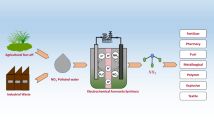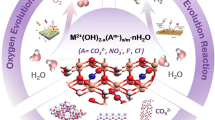Abstract
Kinetics and mechanism of electroreduction of complexes Pd(NH3)4 2+ on a dropping mercury electrode (DME) and a Pd electrode, as well as ammonia complexes of Co(II), Ni(II), and Zn(II) and hydroxyammonia complexes of Zn(II) on DME at different concentrations of ammonia and supporting electrolytes and different pH values are discussed. The half-wave potentials of electroreduction of ammonia complexes of Pd(II) and Ni(II) on DME in the absence of a polarographic maximum obey an equation that takes into account the effect the EDL structure has on the rate of a slow outer-sphere electrochemical stage. As opposed to Pd(II) complexes, the reduction of the other complexes involves preceding reversible chemical stages, which yield diammonia complexes undergoing a direct reduction on DME. The reasons for the emergence of a polarographic maximum upon an increase in the concentration of reduced complexes and the time of recording an instant current are discussed.
Similar content being viewed by others
REFERENCES
Bjerrum, J., Metal Ammine Formation in Aqueous Solution, Kobenhavn: Munksgaard, 1957.
Sillen, L.G. and Martell, A.E., Spec. Publ.-Chem. Soc., 1964, no. 17; 1971, no. 25.
Högfeldt, E., Stability Constants of Metal-Ion Complexes, part A: Inorganic Ligands, New York: Pergamon, 1982.
Bode, H., Z. Anorg. Allg. Chem., 1962, vol. 317, p. 3.
Gerisher, H., Z. Phys. Chem. (Leipzig), 1953, vol. 202, p. 302.
Matsuda, H. and Ayabe, Y., Bull. Chem. Soc. Jpn., 1956, vol. 29, p. 134.
Stromberg, A.G., Zh. Fiz. Khim., 1957, vol. 31, p. 1704.
Matsuda, H. and Ayabe, Y., Z. Elektrochem., 1959, vol. 63, p. 1164.
Molodov, A.I. and Losev, V.V., Elektrokhimiya, 1965, vol. 1, p. 149.
Popova, L.N. and Stromberg, A.G., Elektrokhimiya, 1968, vol. 4, p. 1147.
Eriksrud, E., J. Electroanal. Chem., 1975, vol. 60, p. 41.
Eriksrud, E., J. Electroanal. Chem., 1976, vol. 67, p. 69.
Crow, D.R. and Rose, M.E., Electrochim. Acta, 1979, vol. 24, p. 41.
Urbanska, J., Electrochim. Acta, 1985, vol. 30, p. 261.
Kravtsov, V.I., Ravnovesie i kinetika elektrodnykh reaktsii kompleksov metallov (The Equilibrium and Kinetics of Electrode Reactions Involving Metal Complexes), Leningrad: Khimiya, 1985, p. 208.
Tsventarnyi, E.G., Kravtsov, V.I., Russkikh, Ya.V., and Burogaa, I., Elektrokhimiya, 1997, vol. 33, p. 373.
Astakhova, R.K., Balushkina, S.R., Kravtsov, V.I., and Peganova, N.V., Elektrokhimiya, 1999, vol. 35, p. 1395.
Astakhova, R.K., Kravtsov, V.I., and Peganova, N.V., Elektrokhimiya, 2001, vol. 37, p. 186.
Kravtsov, V.I., Tsventarnyi, E.G., Kurtova, O.Yu., and Nosov, S.N., Elektrokhimiya, 2001, vol. 37, p. 658.
Mairanovskii, S.G., Elektrokhimiya, 1967, vol. 3, p. 1434.
Koryta, J., Collect. Czech. Chem. Commun., 1953, vol. 18, p. 206.
Emsley, J., The Elements, Oxford: Clarendon, 1991.
Brønnum, B., Johansen, H.S., and Skibsted, L.H., Acta Chem. Scand., 1989, vol. 43, p. 975.
Willis, J.B., J. Am. Chem. Soc., 1945, vol. 67, p. 547.
Parry, E.P. and Oldham, K.B., Anal. Chem., 1968, vol. 40, p. 1031.
Kravtsov, V.I., Russkikh, Ya.V., and Tsventarnyi, E.G., Elektrokhimiya, 1999, vol. 35, p. 128.
Heyrovský, J. and Kuta, J., Principles of Polarography, New York: Academic, 1966.
Russell, C.D., J. Electroanal. Chem., 1963, vol. 6, p. 490.
Tsventarnyi, E.G. and Kravtsov, V.I., Elektrokhimiya, 1999, vol. 35, p. 603.
Meites, L. and Israel, Y., J. Am. Chem. Soc., 1961, vol. 83, p. 4903.
Davison, W. and Harrison, J.A., J. Electroanal. Chem., 1972, vol. 36, p. 399.
Vlček, A.A., Z. Elektrochem., 1957, vol. 61, p. 1014.
Author information
Authors and Affiliations
Rights and permissions
About this article
Cite this article
Kravtsov, V.I., Astakhova, R.K., Tsventarnyi, E.G. et al. Electroreduction of Ammonia and Hydroxyammonia Complexes of Divalent Metals: Effect of the Ligand Concentration and the EDL Structure. Russian Journal of Electrochemistry 38, 157–164 (2002). https://doi.org/10.1023/A:1016816231285
Issue Date:
DOI: https://doi.org/10.1023/A:1016816231285




